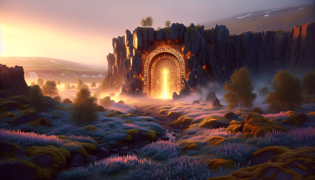Introduction
I still remember the first time I heard the wind whisper its secret through the fissures of Þingvellir. It was a night edged with anticipation, the air tasting of sea salt and glacier melt, cool against my lips as I pitched my tent on the edge of Almannagjá canyon. Stars hung like struggling lanterns in the crystal sky, and the distant rumble of tectonic plates shifting beneath my boots felt both ominous and sacred. I had come seeking the Golden Door—an ancient portal said to appear only at the moment the sun peered over the horizon at midsummer’s dawn. My guidebook mentioned it almost in passing, as though it were no more remarkable than a hidden waterfall or a secret hot spring.
That guidebook had been penned by Jón Þórhallsson, a lifelong wanderer of this land, who wrote in his diary of runes glowing like fireflies on basalt, of whispers rising from fissures that could be heard only in the stillness before sunrise. His words felt alive, each sentence a heartbeat pulsing with longing. I traced his route in the pale glow of my headlamp—through fields of purple lupine trembling in the midnight breeze, across smooth flagstones slick with dew, and beneath an ancient birch grove whose branches twisted toward the sky like beseeching hands. My boots pressed into soft moss, the scent of damp earth and bracken rising each time I exhaled. The ground hummed faintly beneath my feet, as though it remembered every gathering of the Alþingi, Iceland’s first parliament, convened here a thousand years before.
As the hours ticked by, the horizon lightened to a bruise-purple band, and the wind fell away to an expectant hush that crackled against my skin like static. My breath formed little clouds in the air, and I tasted something sharp—like iron on my tongue—when I knelt by a cluster of runes etched into the stone. They glowed faintly, as if awakened by my touch. I felt the weight of centuries settle onto my shoulders, each exhale a prayer to gods long silent.
Then, just as my heart threatened to still in wonder, a golden gleam flickered at the base of a basalt outcrop. I blinked, unwilling to believe my eyes, yet the glimmer grew into a full radiance that bathed the rift in molten light. There, set into the cliffside, was the door—tall, arched, and plated in beaten gold, its surface etched with knotwork and rune-script that pulsed like embers in a hearth. A hush deeper than night descended, and even the stones seemed to lean closer, eager to witness what would happen next. I swallowed hard, the taste of smoke and salt trailing down my throat, and felt the door’s presence reach for me, an invitation written in sunlight and shadow. The Golden Door of Þingvellir had appeared.
Journey to the Rift
My journey to Þingvellir had begun days earlier in Reykjavík, where the city’s hum still clung to my clothes like a stubborn dye. I traded the buzz of neon signs and traffic for the hush of empty roads and distant gull cries, heading east into the Highlands. Each kilometer shed layers of noise, replaced by the rhythmic roll of volcano-carved hills and the crisp tang of birch smoke rising from hidden cottages. I stopped at a roadside farmhouse, where an old woman named Sigríður offered me a bowl of skyr and crusty rye bread. Her eyes, pale as glacier ice, held a flicker of something knowing when I mentioned the Golden Door. She warned me, in a voice rough as lava rock, that some doors guard secrets too heavy for the living. But her warning was laced with welcome—an invitation as much as a caution.
From there, I followed unmarked trails that snaked along the rift valley, each step crunching on gravel and volcanic ash. The land was scarred in places, deep fissures yawning like the open throats of giant beasts. Ásbyrgi canyon lay to the north, a mighty horseshoe carved by glacial floods, but I stuck close to the marked paths leading to Almannagjá, the Great Cleft. There, the earth itself spoke in groans and whispers, a living vein pulsing with heat and memory. I paused at a heated spring where steam billowed from dark water, carrying the scent of sulfur and wild thyme. Nearby, lupine and moss flaunted their purple and emerald carpets, bright against the charcoal rock.
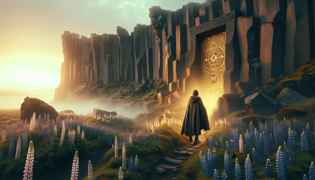
As I climbed the steep slope toward the plateau where the Alþingi once convened, the wind sharpened in my ears. It carried a melody faint and fractured—like a horn call from a distant battlefield, or the echo of a long-forgotten hymn. I followed that sound, half-doubting it was anything more than a trick of the breeze. But when I neared a narrow cleft in the basalt, the melody resolved into whispered voices chanting names in Old Norse: “Þorfinnr, Ingólfr, Snorri…” Each name rose and fell in a cadence that felt like an invocation.
I crouched beside the cleft’s edge, the stone warm against my palm, and watched as dust motes drifted in the slanted rays of pre-dawn light. The air smelled of damp stone and the faintest hint of juniper. I traced my fingers along the rune-carvings there—tiny grooves like river tributaries—feeling a thrum beneath the rock that matched my own pulse. The voices grew louder, an undercurrent of chieftains’ voices echoing across centuries, guiding me onward. With a final deep breath of frost-kissed air, I stood and stepped through, emerging on the narrow shelf where the Golden Door awaited its moment.
Whispers among the Rocks
The moments before the door’s full reveal were charged with anticipation so thick I could taste it—salty and metallic—on my tongue. Shadows clung to the basalt like dark velvet drapes, and the silence was so complete that my own heartbeat seemed an intruder. I pressed my ear to the stone wall beside the arch, feeling a low vibration, as though something immense stirred just beyond the surface. The rune-carvings danced with a pale luminescence, each stroke of ink-dark stone outlined in gold-hued light.
I spoke quietly, offering thanks to the land and to the spirits who guarded it. My voice echoed back, altered by the living rock, as if the canyon itself answered. A breeze rose through the chasm, carrying the scent of molten iron and wild moss, a combination both feral and comforting. The wind whispered in a tongue I almost understood: names of chiefs—Þorgeir Ljósvetningagoði, Njáll Þorgeirsson—titans of early Icelandic lawmaking whose wisdom shaped this place. Each exhalation by the earth felt like a breath from the souls of those who came before.
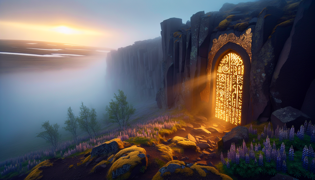
As light seeped into the rift, the Golden Door began to shimmer. It was no longer merely gold plating on stone but a living surface that rippled like liquid metal. Small figures etched around the arch—chieftains seated at lawrounds—seemed to shift in their relief-carvings, their features animated by dawn’s glow. I felt their gaze upon me—stern, expectant, as though they waited for an answer.
I laid a hand on the door’s surface, expecting the cold of metal, but instead felt warmth—inviting warmth—like a hearth’s embrace. The world behind that door throbbed with possibility: a realm of echoes where time folded back on itself and knowledge slept beneath layers of rock and legend. I closed my eyes and heard a chorus of voices, faint yet insistent, reciting laws and proverbs in an ancient rhythm. The sense of history was palpable; I could smell the smoke of long-extinguished torches and taste the ashes of sacrifices offered to honor the land.
All at once, a shaft of sunlight pierced the horizon, striking the center of the arch. The Gold Door flared, and the runes flared with it, illuminating the cleft as though lightning had struck. My breath caught on the crest of that brilliance. The air rippled, and the world beyond the threshold pulsed with color—emerald ferns unfurling, raven wings beating in slow motion, hands of stone reaching skyward.
I stepped forward, crossing the threshold into a world both familiar and strange—where the spirits of Iceland’s earliest lawmakers stood ready to share their counsel. The ground hummed beneath my boots as whispers crowded my ears. I had found the Golden Door, and with it the voices of the past, waiting to guide the future.
The Door at Dawn
When the sun finally crested the eastern horizon, the plateau erupted in golden fire. Light spilled across the fissure, igniting every rune, every relief-carving, every grain of moss with a brilliance that hurt the eyes. The Golden Door seemed to breathe, expanding and contracting in rhythm with my pulse. I stood transfixed, feeling the dawn’s warmth seep into my bones as if I were part of the land itself.
From beyond the threshold came a soft melody—an ancient chant that rose and fell like the tide. It spoke of honor and justice, of community bound by law and tradition. Each note felt woven from wind and stone, as though the very earth sang in celebration of midsummer’s return. I realized then that this portal was more than a relic; it was a living monument to the wisdom and governance that first united this island’s settlers.
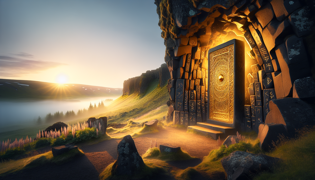
I reached out to touch the door once more, and this time it opened silently, swinging inward on unseen hinges. Inside was a chamber carved from the same basalt, walls inscribed with sagas that I could almost decipher. The air was cool and fragrant with the scent of heather and pine resin. Light filtered through cracks in the ceiling, illuminating dust motes that danced like tiny sprites. Ahead stood a circle of thrones, each hewn from stone and faced toward a central pillar crowned with a carved figure of a wise chieftain.
I stepped inside, every footfall echoing like a question. The door whispered closed behind me, sealing out the world I knew. Before I could fully absorb the sight, a voice—deep and resonant—spoke in Old Norse: “Welcome, seeker of wisdom. To whom do you pledge your journey?” My cheeks warmed at the sound, a vibration that rumbled through the chamber floor. I hesitated, senses alight with wonder: the scent of beeswax from long-burned torches, the tang of aged wood in ceremonial chairs, the metallic shimmer of ancestral armor displayed like trophies.
Steeling myself, I answered: “To knowledge, and to those who guard it.” The chamber brightened in response, as though approving my pledge. The runes on the walls glowed brighter, revealing scenes of assembly and debate, of chieftains deliberating under open skies. I realized the door existed not to trap, but to teach: to connect living hearts with the spirits of those who shaped Iceland’s destiny.
Sunlight flooded the threshold once more, and I knew my time was short. I bowed my head to the carved figure on the central pillar, feeling an unspoken bond form across a millennium. Then I stepped back into the dawn, the door closing behind me with the soft sigh of closing book covers. I emerged onto the plateau, the morning sun washing the land in a promise of renewal. My heart thundered with the door’s gift: a living inheritance of law, wisdom, and unity to carry forward.
Guardians of the Golden Portal
The Golden Door vanished from sight as quickly as it had appeared, leaving only a smooth basalt wall etched now with faint fingerprints of shimmering gold. I ran my fingers along the cold stone, the early sun warming my skin. The portal’s memory burned bright in my mind, and I felt its charge: a responsibility to safeguard the wisdom entrusted to me.
Below the plateau lay the modern world—tents of tourists, snap-happy travelers, and guides repeating tired stories about tectonic plates. They saw only fissures and lava fields; they never perceived the door or heard the chieftains’ voices on the wind. I understood then that Þingvellir’s true magic survived in those silent widths between worlds, sacrosanct and unseen by all but the chosen.
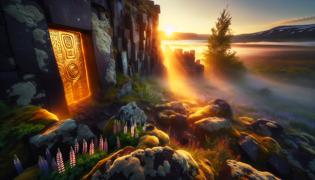
Days later, back in Reykjavík’s hum, I found myself pausing at rune-inscribed manhole covers and basalt pavers, my mind searching for echoes of that chamber’s melody. I dreamed of the runic scripts, of chairs carved from living rock, of voices calling across centuries. I carried fragments of those songs with me—snatches of chant, the rhythm of invoked laws, the pulse of ancient governance.
In the weeks that followed, I returned to Þingvellir often, each time finding the basalt wall unchanged, the fabled cleft tucked in shadow. I offered simple gifts—pebbles gathered from distant shores, dried moss from remote valleys—placing them where the runes had glowed. In return, I felt guidance: in a thoughtful decision, a word of counsel from a trusted friend, and in the unspoken bonds formed around a fire’s glow.
I came to realize that the Golden Door’s true guardianship lies not in a physical threshold, but in living communities that carry forward the lessons of unity and justice. Each midsummer dawn, if you listen closely, you can hear the slightest shift in the basalt, a distant murmur of voices rising with the sun. And if you are open—heart and mind—you might glimpse a flicker of gold at the horizon’s edge and feel the gentle pull of ancestral hands.
For the Golden Door of Þingvellir remains as ever: a portal of promise, a beacon of shared heritage, waiting at the moment when earth and sky embrace. Its spirits endure in every gathering where voices join in council, in every decision made with integrity, and in every heart that honors the wisdom of those who came before.
Conclusion
Long after I left Iceland, the memory of that midsummer dawn stayed with me. In my dreams, I hear the echo of chieftains’ voices carried on the wind, urging me to uphold the unity they forged on Þingvellir’s stones. The Golden Door may appear only once a year, but its wisdom waits in every moment of honest counsel, in every heart that seeks truth beyond sight. I keep a fragment of basalt runes on my desk—a silent reminder of the threshold I crossed and the legacy I carry. If you ever stand in the rift at dawn’s first light, listen for the hum beneath your feet and look for the glimmer in basalt’s cracks. The door may reveal itself to you, and if it does, may your pledge be worthy of the ancient spirits it guards.
